Thursday, December 5 | 11:00 a.m.-11:10 a.m. | SSQ05-04 | Room E350
Researchers from the U.S. National Institutes of Health are following the adage "less is more" in their development of a 0.55-tesla MRI system for lung imaging.Their goal is to prove that a high-performance, low-field scanner can overcome MRI's notorious issues in lung imaging. The group's approach involves enhancing field homogeneity for prolonged T2-weighted imaging of the lung parenchyma and increasing oxygen relaxivity for the functional assessment of lung ventilation.
Research fellow Ipshita Bhattacharya, PhD, and colleagues have created and tested a prototype 0.55-tesla system that is a modified version of Siemens Healthineers' Magnetom Aera. The researchers were attracted to its magnet design, fast gradient design, modern radiofrequency system, custom phased-array coils, and advanced imaging methods
Images from the 0.55-tesla system were compared with those from the 1.5-tesla version of Magnetom Aera. T2-weighted turbo spin echo was used for anatomical lung imaging and 3D oxygen-enhanced ultrashort echo time (TE) imaging was used on healthy volunteers and patients with lung disease.
The 0.55-tesla images delivered "superior visualization" of the lung parenchyma, compared with 1.5-tesla MRI, Bhattacharya and colleagues found. The 0.55-tesla images also provided useful insight into lung pathology, including the assessment of cysts and bronchial wall thickening.
They credited the encouraging results to the improved homogeneity, minimized susceptibility gradients at air-tissue interfaces, and longer T2-weighted imaging of lung tissue.
"Low-field MRI with modern magnet design may provide a unique opportunity for functional assessment of the lung by virtue of the improved field uniformity and improved oxygen contrast performance," the researchers concluded.



.fFmgij6Hin.png?auto=compress%2Cformat&fit=crop&h=100&q=70&w=100)




.fFmgij6Hin.png?auto=compress%2Cformat&fit=crop&h=167&q=70&w=250)











